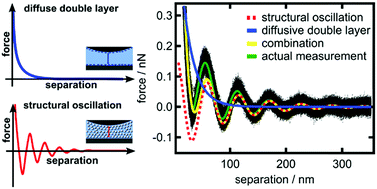Experimental evaluation of additional short ranged repulsion in structural oscillation forces†
Abstract
The paper addresses additional short ranged repulsion in structural oscillation forces between silica surfaces across a suspension of silica nanoparticles. Fit and prediction of the structural oscillation forces usually involve an exponentially decreasing harmonic as introduced by Israelachvili [Israelachvili, Intermolecular & surface forces, Academic Press, San Diego, USA, 1985]. Recently we demonstrated, for aqueous suspensions of silica nanoparticles at various concentrations, that this fit equation is insufficient to describe the structural oscillation forces in its whole range [Schön et al., Beilstein J. Nanotechnol., 2018, 9, 1095–1107]. An additional force acting on short separations leads to the fit parameters scattering widely as well as being dependent on each other and the starting point of the fit. An additional repulsive term was introduced to solve these problems. The additional repulsive force has also been observed by others, in ionic liquids and polyelectrolyte solutions at high ionic strength. It was attributed to the diffusive double layer forces. The rise of the additional repulsion with increasing particle concentration seems to conflict with this interpretation. In this work, colloidal probe atomic force microscopy is used in aqueous suspensions of silica nanoparticles to investigate other contributing factors such as the increasing hydrodynamic drag in the normal direction to the confining surface with increasing particle concentration. A kinetic component to the structural oscillation forces is observed. Furthermore, sodium chloride is used to adjust the ionic strength of two different concentrated silica nanoparticle suspensions. For these systems the additional decay length is compared to the Debye length in the range from low to high ionic strength. A master curve of the additional decay length over Debye length at different ionic strengths, approach speed and particle concentration is produced. It affirms the link between the two and the connection between the additional force and the diffusive double layer forces. The increasing trend for the additional repulsion with increasing particle concentration reveals a synergistic effect of diffusive double layer forces and structural oscillation forces at low to medium ionic strength, which cannot be observed at high ionic strength.



 Please wait while we load your content...
Please wait while we load your content...